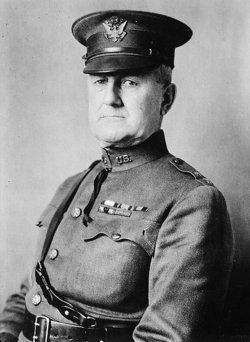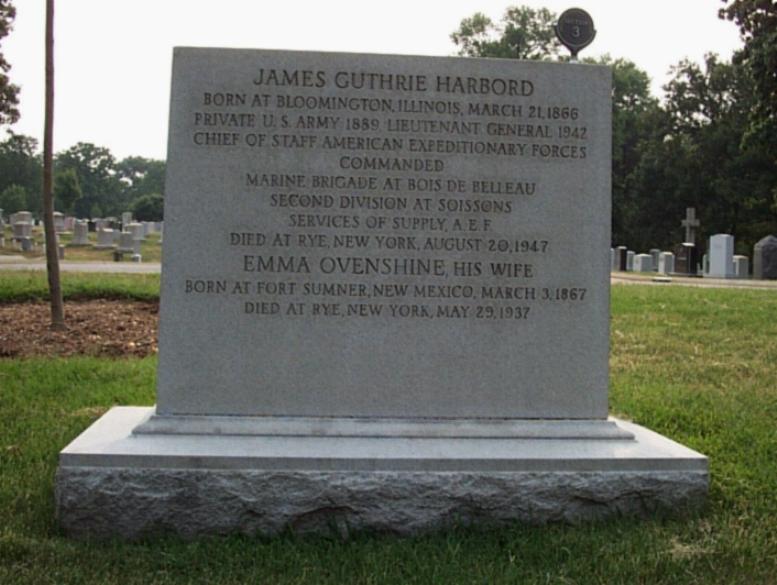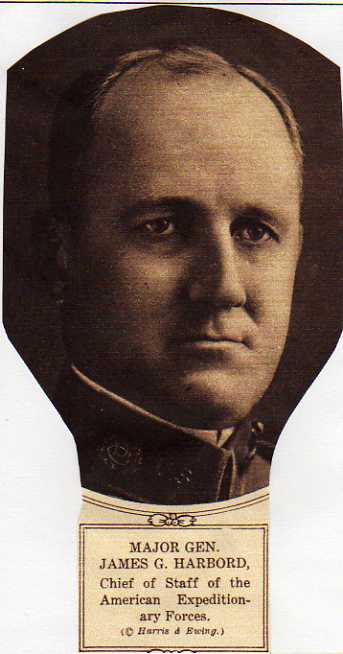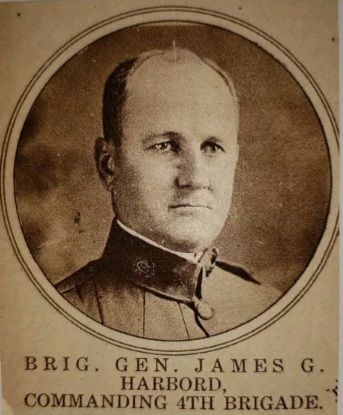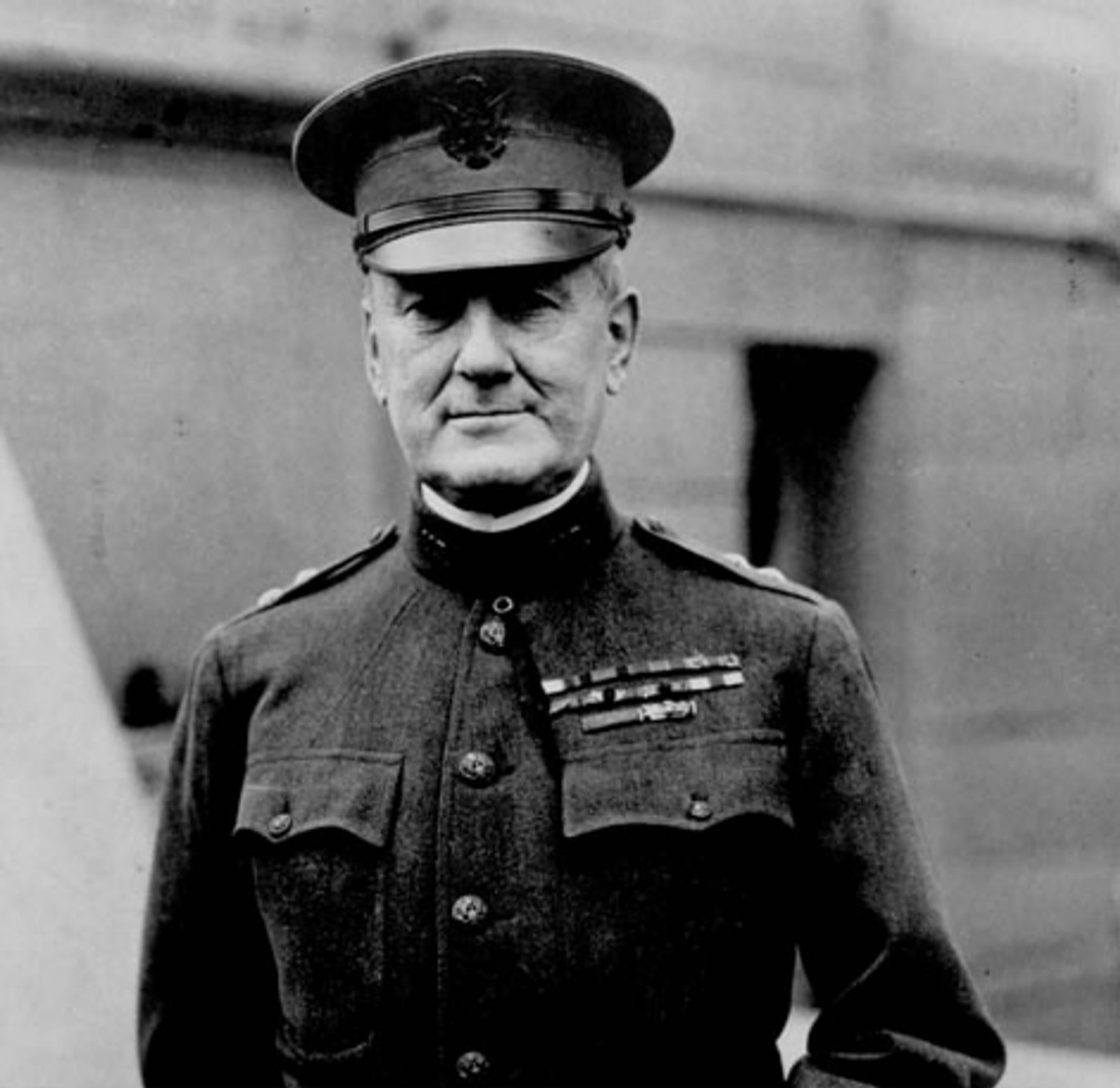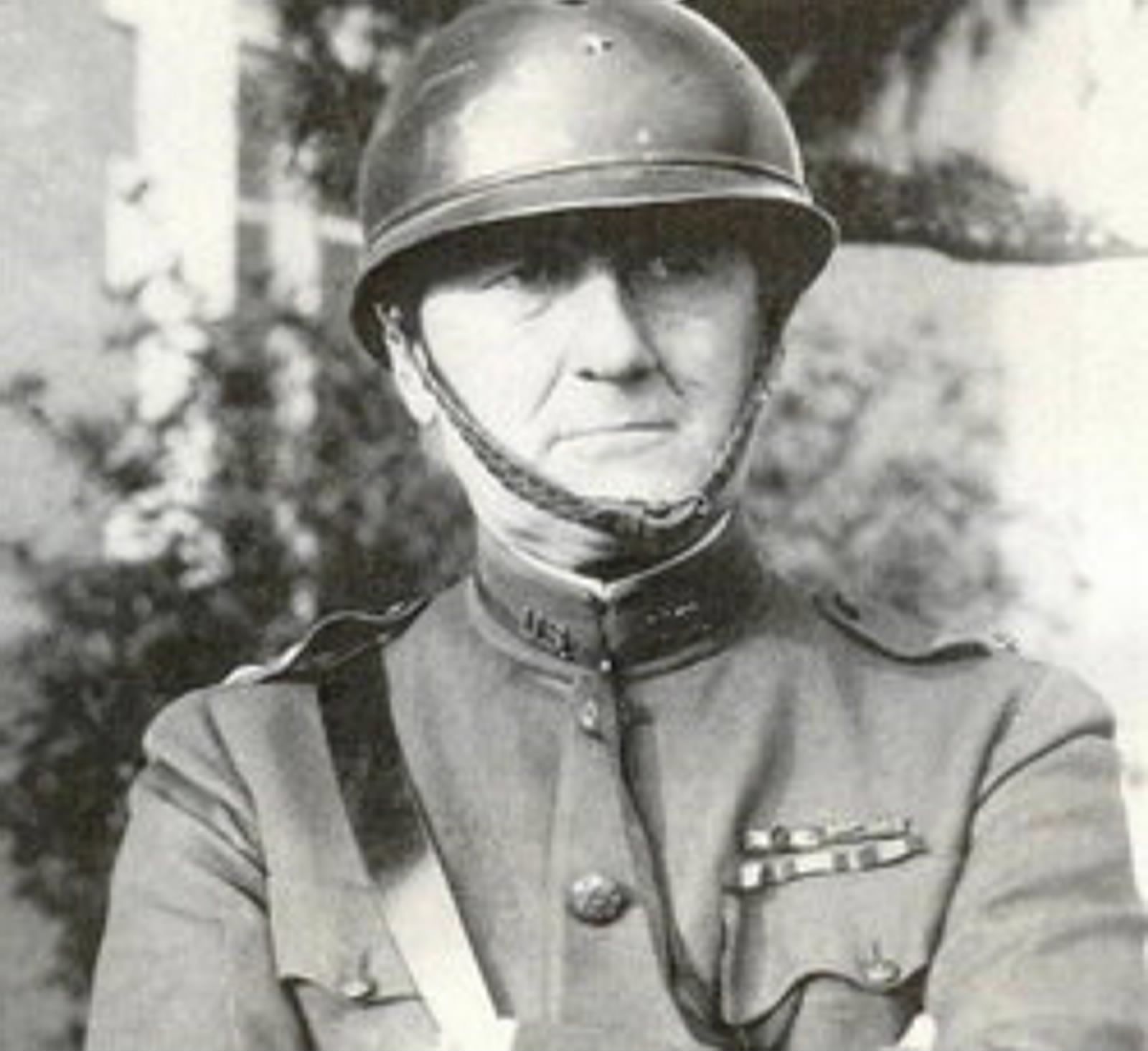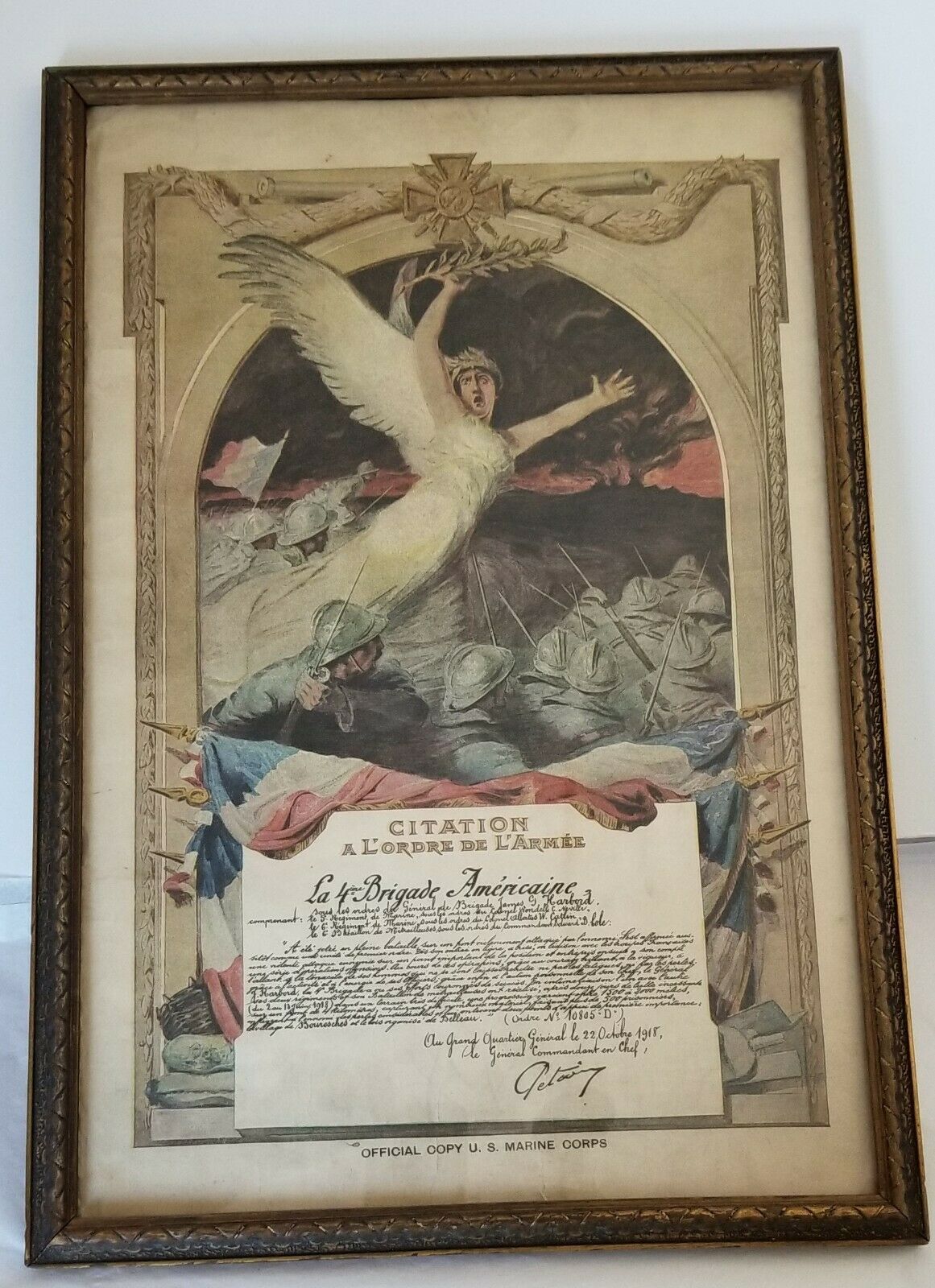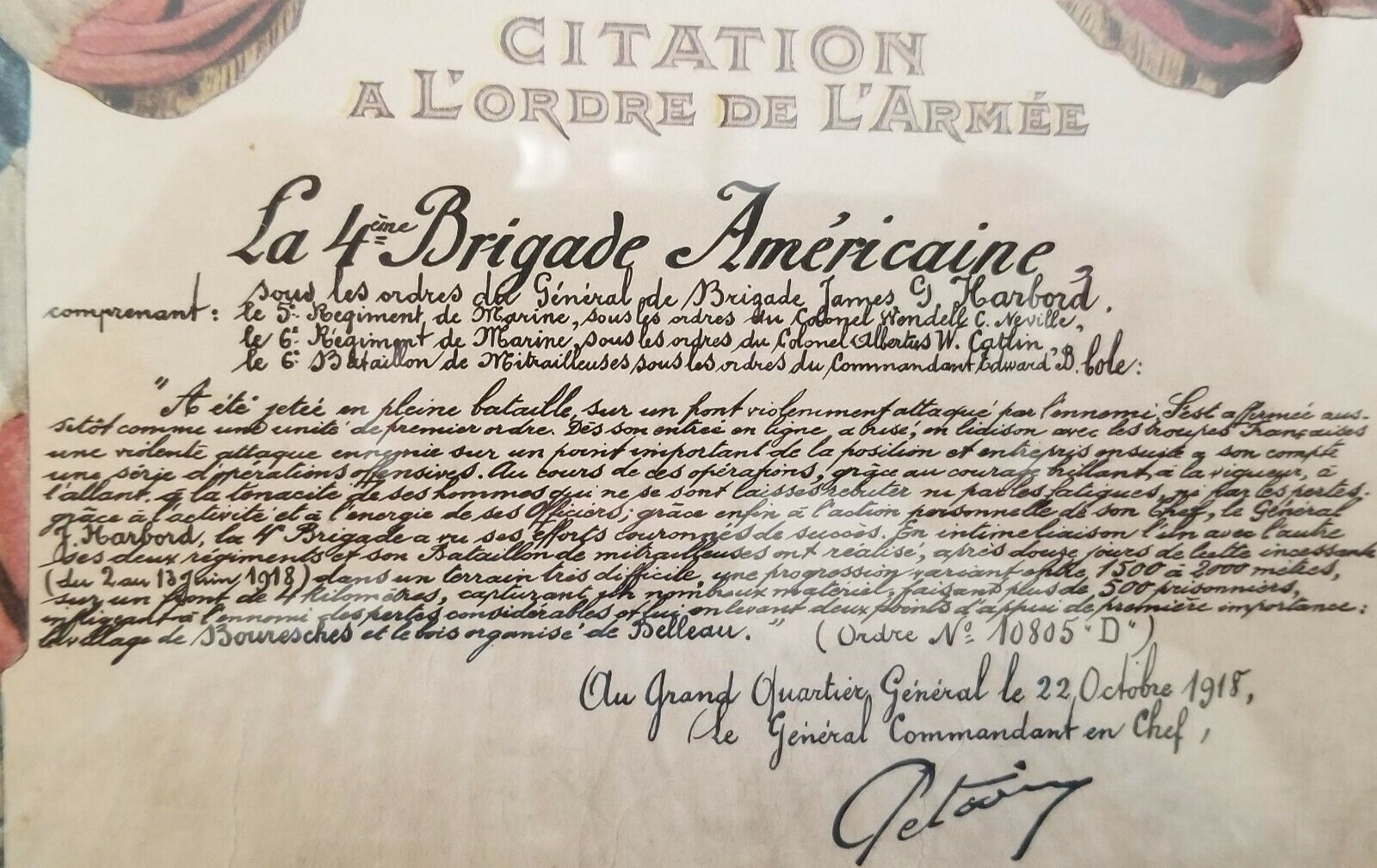Harbord was born in Bloomington, Illinois, the son of George W. and Effie (Gault) Harbord. His family moved when he was four, and Harbord was raised in Pettis County, Missouri and Lyon County, Kansas. He graduated from Kansas State Agricultural College with a Bachelor of Science degree in 1886. After unsuccessfully applying to the United States Military Academy, Harbord turned to teaching school, and afterwards taught at the agricultural college. In January 1889, Harbord enlisted in the United States Army, joining the 4th Infantry Regiment as a private. He served in the enlisted ranks until July 1891, and advanced to corporal, sergeant, and regimental quartermaster sergeant. In August 1891, Harbord was commissioned as a second lieutenant in the 5th Cavalry Regiment. He received a Master of Science degree from Kansas State Agricultural College in 1895.
Harbord's first overseas experience came as a member of the occupation army in Cuba after the Spanish–American War. On January 21, 1899, during an extended leave, he married Emma Yeatman Overshine, daughter of Brigadier General Samuel Ovenshine. In 1901, he was promoted to captain and transferred from Cuba, where he has served initially as quartermaster and commissary for the 10th Cavalry Regiment, and later as aide-de-camp and adjutant-general of the department of Santiago and Puerto Principe.
After serving briefly in the Secretary of War office, he requested and received transfer to duty in the Philippines with the 11th Cavalry Regiment. He then served as Assistant Chief of the Philippine Constabulary from 1903 to 1909 and again from 1910 through 1913. By late April 1914 he was commanding the unit defending the California border at Calexico. In 1916, he was on the Mexican border with Brigadier General John J. Pershing, pursuing Pancho Villa.
When the United States entered World War I in April 1917, General Harbord was hand picked by General Pershing to be his chief of staff in France, which won him a promotion to brigadier general. Together with Pershing and thirty other generals, they set sail for England on 28 May 1917. Harbord worked closely with Pershing, now the commander of the American Expeditionary Forces (AEF) on the Western Front, on the buildup of the American Expeditionary Force (A.E.F.) in France, including the shipping schedules of American forces being sent to Europe. Following a great German offensive against the Western Front on March 21, 1918, the English and French armies were in retreat, and the need for American troops was urgent. Previously agreed to arrangements to provide 120,000 servicemen a month for three months was cast aside when General Pershing was informed by the English that by using confiscated Dutch shipping, over 300,000 soldiers could be sent a month. However, due to manpower attrition within the British Expeditionary Force (B.E.F.), its combat divisions were reduced in strength by 25%, and with the breakthrough on the front, the English were asking that only infantry and machine gun battalions be sent over, and all other units be held back. The American policy on this matter was quite different: General Pershing was sent to France to organize American Armies under American leadership; the idea that its combat units would be used solely as replacement units, or as reinforcements, for foreign countries was unthinkable. President Wilson would not agree to this. He thought the idea would not go over well with the American public, and it risked preventing an American army from ever being formed. In secret conversations, General Pershing even said he was willing to risk the fall of France, because the United States would still carry on the war against the Kaiser; if his forces were stripped away from him and the allies lost, then Germany would win complete victory. For his part, Prime Minister Clemenceau thought this plan appealed to the romantic side of America's intervention.
During a conference in Versailles on March 28, President Wilson shifted his position on American ground forces by allowing the temporary duty of A.E.F. combat units in the English and French ranks. This was confirmed in, "The London Agreement" of April 27. In a follow up conversation between Lord Reading, the English Ambassador to the United States, and General Harbord, the ambassador said the English would be willing to supply the transportation of 120,000 American infantry and machine gun unit personnel to France, if the United States could supply the men. General Harbord says the statement was like, "the sun breaking through the clouds" because, "If Great Britain can give us the ships to carry infantry alone, she could not refuse to carry troops from any other arm of the service. Accordingly, I said to him, 'Give me the ships, and I will furnish 120,000 men a month.'" When the ships arrived, the ship captains were instructed to accept only infantry and machine gun units. When Lord Reading found out that complete divisions were assembling, he was furious. When he was told that he must have misunderstood his conversation with Harbord, it looked like a conspiracy was in the works by the American generals. As a result of this, at the beginning of May 1918, General Pershing transferred out much of his staff who he said, 'were to complacent about themselves, and how things are run around here'. The first to go was General Harbord, who was sent forward to the trenches to command a Marine Brigade. However, due to General Harbord's decision, the American position prevailed, and full American divisions kept coming, so much so that by the time of the Armistice, the A.E.F. was two million men strong, two full American armies were formed, and a third was ready and deployed to the Rhineland in January 1919. In all, 40 complete divisions had arrived, 30 were fielded, and 10 were under temporary British control. A complete list of A.E.F. divisions can be found here.
In June 1918, Harbord was succeeded by James W. McAndrew as AEF chief of staff, and assigned to command of the 4th Marine Brigade, which was serving as part of the 2nd Infantry Division, and then on July 15, briefly given command of the division itself. He immediately saw action, commanding the U.S. Marines at the famous battles of Château-Thierry and Belleau Wood.
After generals Richard Blatchford and his replacement, Francis Kernan, had failed to organize an adequate delivery of supplies to the US troops in France, John J. Pershing asked Harbord in August 1918 to take the job. Harbord introduced several reforms to the ″Services of Supply″ (SOS) and achieved almost instant improvements. The task of anticipating the arrival of divisions in France, and their type, and having in place the correct amount of supplies for them at the rear, toward the front, and at the front, was all worked out. Too, it was at Harbord's insistence that SOS became fully integrated among the American, English, and French armies. Pershing's trust in Harbord went so far, that Jim Lacey wrote in his Pershing biography "if a problem were outside Harbord's ability to solve, it was not solvable by mortal man"
Following the war, he was promoted to major general and was awarded the Army Distinguished Service Medal. In August 1919, President Woodrow Wilson sent a fact-finding mission to the Middle East, headed by Harbord, to investigate the feasibility of the Balfour Declaration, which supported the creation of a Jewish state in Palestine, taken from the Ottoman Empire during the war. Harbord was also to report on Turkish–Armenian relations in the wake of the Armenian genocide. Upon returning to the United States, Harbord wrote the Conditions in the Near East: Report of the American Military Mission to Armenia, which was a summary of the expedition that provided various details of the mission. The report includes maps, statistics, and a historical analyses of the country and its population. In addition to such details, Harbord collected evidence and information regarding the massacres of Armenians. Harbord's report stated that "the temptation to reprisals for past wrongs" would make it extremely difficult to maintain peace in the region. The final conclusion of the report was the inclusion of Armenia in the possible American mandate for Asia Minor and Rumelia since a mandate for Armenia alone was not deemed feasible under these conditions.
Following the war, he was promoted to major general and was awarded the Army Distinguished Service Medal.
In August 1919, President Woodrow Wilson sent a fact-finding mission to the Middle East, headed by Harbord, to investigate the feasibility of the Balfour Declaration, which supported the creation of a Jewish state in Palestine, taken from the Ottoman Empire during the war. Harbord was also to report on Turkish–Armenian relations in the wake of the Armenian genocide. Upon returning to the United States, Harbord wrote the Conditions in the Near East: Report of the American Military Mission to Armenia, which was a summary of the expedition that provided various details of the mission. The report includes maps, statistics, and a historical analyses of the country and its population. In addition to such details, Harbord collected evidence and information regarding the massacres of Armenians. Harbord's report stated that "the temptation to reprisals for past wrongs" would make it extremely difficult to maintain peace in the region. The final conclusion of the report was the inclusion of Armenia in the possible American mandate for Asia Minor and Rumelia since a mandate for Armenia alone was not deemed feasible under these conditions.
Harbord was born in Bloomington, Illinois, the son of George W. and Effie (Gault) Harbord. His family moved when he was four, and Harbord was raised in Pettis County, Missouri and Lyon County, Kansas. He graduated from Kansas State Agricultural College with a Bachelor of Science degree in 1886. After unsuccessfully applying to the United States Military Academy, Harbord turned to teaching school, and afterwards taught at the agricultural college. In January 1889, Harbord enlisted in the United States Army, joining the 4th Infantry Regiment as a private. He served in the enlisted ranks until July 1891, and advanced to corporal, sergeant, and regimental quartermaster sergeant. In August 1891, Harbord was commissioned as a second lieutenant in the 5th Cavalry Regiment. He received a Master of Science degree from Kansas State Agricultural College in 1895.
Harbord's first overseas experience came as a member of the occupation army in Cuba after the Spanish–American War. On January 21, 1899, during an extended leave, he married Emma Yeatman Overshine, daughter of Brigadier General Samuel Ovenshine. In 1901, he was promoted to captain and transferred from Cuba, where he has served initially as quartermaster and commissary for the 10th Cavalry Regiment, and later as aide-de-camp and adjutant-general of the department of Santiago and Puerto Principe.
After serving briefly in the Secretary of War office, he requested and received transfer to duty in the Philippines with the 11th Cavalry Regiment. He then served as Assistant Chief of the Philippine Constabulary from 1903 to 1909 and again from 1910 through 1913. By late April 1914 he was commanding the unit defending the California border at Calexico. In 1916, he was on the Mexican border with Brigadier General John J. Pershing, pursuing Pancho Villa.
When the United States entered World War I in April 1917, General Harbord was hand picked by General Pershing to be his chief of staff in France, which won him a promotion to brigadier general. Together with Pershing and thirty other generals, they set sail for England on 28 May 1917. Harbord worked closely with Pershing, now the commander of the American Expeditionary Forces (AEF) on the Western Front, on the buildup of the American Expeditionary Force (A.E.F.) in France, including the shipping schedules of American forces being sent to Europe. Following a great German offensive against the Western Front on March 21, 1918, the English and French armies were in retreat, and the need for American troops was urgent. Previously agreed to arrangements to provide 120,000 servicemen a month for three months was cast aside when General Pershing was informed by the English that by using confiscated Dutch shipping, over 300,000 soldiers could be sent a month. However, due to manpower attrition within the British Expeditionary Force (B.E.F.), its combat divisions were reduced in strength by 25%, and with the breakthrough on the front, the English were asking that only infantry and machine gun battalions be sent over, and all other units be held back. The American policy on this matter was quite different: General Pershing was sent to France to organize American Armies under American leadership; the idea that its combat units would be used solely as replacement units, or as reinforcements, for foreign countries was unthinkable. President Wilson would not agree to this. He thought the idea would not go over well with the American public, and it risked preventing an American army from ever being formed. In secret conversations, General Pershing even said he was willing to risk the fall of France, because the United States would still carry on the war against the Kaiser; if his forces were stripped away from him and the allies lost, then Germany would win complete victory. For his part, Prime Minister Clemenceau thought this plan appealed to the romantic side of America's intervention.
During a conference in Versailles on March 28, President Wilson shifted his position on American ground forces by allowing the temporary duty of A.E.F. combat units in the English and French ranks. This was confirmed in, "The London Agreement" of April 27. In a follow up conversation between Lord Reading, the English Ambassador to the United States, and General Harbord, the ambassador said the English would be willing to supply the transportation of 120,000 American infantry and machine gun unit personnel to France, if the United States could supply the men. General Harbord says the statement was like, "the sun breaking through the clouds" because, "If Great Britain can give us the ships to carry infantry alone, she could not refuse to carry troops from any other arm of the service. Accordingly, I said to him, 'Give me the ships, and I will furnish 120,000 men a month.'" When the ships arrived, the ship captains were instructed to accept only infantry and machine gun units. When Lord Reading found out that complete divisions were assembling, he was furious. When he was told that he must have misunderstood his conversation with Harbord, it looked like a conspiracy was in the works by the American generals. As a result of this, at the beginning of May 1918, General Pershing transferred out much of his staff who he said, 'were to complacent about themselves, and how things are run around here'. The first to go was General Harbord, who was sent forward to the trenches to command a Marine Brigade. However, due to General Harbord's decision, the American position prevailed, and full American divisions kept coming, so much so that by the time of the Armistice, the A.E.F. was two million men strong, two full American armies were formed, and a third was ready and deployed to the Rhineland in January 1919. In all, 40 complete divisions had arrived, 30 were fielded, and 10 were under temporary British control. A complete list of A.E.F. divisions can be found here.
In June 1918, Harbord was succeeded by James W. McAndrew as AEF chief of staff, and assigned to command of the 4th Marine Brigade, which was serving as part of the 2nd Infantry Division, and then on July 15, briefly given command of the division itself. He immediately saw action, commanding the U.S. Marines at the famous battles of Château-Thierry and Belleau Wood.
After generals Richard Blatchford and his replacement, Francis Kernan, had failed to organize an adequate delivery of supplies to the US troops in France, John J. Pershing asked Harbord in August 1918 to take the job. Harbord introduced several reforms to the ″Services of Supply″ (SOS) and achieved almost instant improvements. The task of anticipating the arrival of divisions in France, and their type, and having in place the correct amount of supplies for them at the rear, toward the front, and at the front, was all worked out. Too, it was at Harbord's insistence that SOS became fully integrated among the American, English, and French armies. Pershing's trust in Harbord went so far, that Jim Lacey wrote in his Pershing biography "if a problem were outside Harbord's ability to solve, it was not solvable by mortal man"
Following the war, he was promoted to major general and was awarded the Army Distinguished Service Medal. In August 1919, President Woodrow Wilson sent a fact-finding mission to the Middle East, headed by Harbord, to investigate the feasibility of the Balfour Declaration, which supported the creation of a Jewish state in Palestine, taken from the Ottoman Empire during the war. Harbord was also to report on Turkish–Armenian relations in the wake of the Armenian genocide. Upon returning to the United States, Harbord wrote the Conditions in the Near East: Report of the American Military Mission to Armenia, which was a summary of the expedition that provided various details of the mission. The report includes maps, statistics, and a historical analyses of the country and its population. In addition to such details, Harbord collected evidence and information regarding the massacres of Armenians. Harbord's report stated that "the temptation to reprisals for past wrongs" would make it extremely difficult to maintain peace in the region. The final conclusion of the report was the inclusion of Armenia in the possible American mandate for Asia Minor and Rumelia since a mandate for Armenia alone was not deemed feasible under these conditions.
Following the war, he was promoted to major general and was awarded the Army Distinguished Service Medal.
In August 1919, President Woodrow Wilson sent a fact-finding mission to the Middle East, headed by Harbord, to investigate the feasibility of the Balfour Declaration, which supported the creation of a Jewish state in Palestine, taken from the Ottoman Empire during the war. Harbord was also to report on Turkish–Armenian relations in the wake of the Armenian genocide. Upon returning to the United States, Harbord wrote the Conditions in the Near East: Report of the American Military Mission to Armenia, which was a summary of the expedition that provided various details of the mission. The report includes maps, statistics, and a historical analyses of the country and its population. In addition to such details, Harbord collected evidence and information regarding the massacres of Armenians. Harbord's report stated that "the temptation to reprisals for past wrongs" would make it extremely difficult to maintain peace in the region. The final conclusion of the report was the inclusion of Armenia in the possible American mandate for Asia Minor and Rumelia since a mandate for Armenia alone was not deemed feasible under these conditions.
